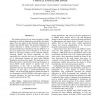Free Online Productivity Tools
i2Speak
i2Symbol
i2OCR
iTex2Img
iWeb2Print
iWeb2Shot
i2Type
iPdf2Split
iPdf2Merge
i2Bopomofo
i2Arabic
i2Style
i2Image
i2PDF
iLatex2Rtf
Sci2ools
IGARSS
2009
2009
Developing a Neural-network-based "BRDF" Tool for the UAE Coastal and Inland Zones
The radiation reflected by any observed surface is highly dependent on both sun illumination and satellite observation angles. These two angles are also described, respectively, as incident and reflected angles. The geometry-dependence of surface reflectance is usually corrected by a tailored Bidirectional Reflectance Distribution Function (BRDF). It is the most common tool used to eliminate or to reduce the effects of sun-sensor geometry on the reflected radiation. Generally, BRDFs are derived empirically (or semiempirically) for a specific land cover by analyzing a large set of observations (training set) made under different illumination and observation angles. This approach involves fitting the model to collected observations and inverting it. A strong BRDF model tailored to specific land cover characteristics of the UAE is especially needed for applications that use data acquired with variable sun-sensor geometry. In this paper, a neural-network-based tool "BRDF" was de...
| Added | 20 Feb 2011 |
| Updated | 20 Feb 2011 |
| Type | Journal |
| Year | 2009 |
| Where | IGARSS |
| Authors | Ali Al Suwaidi, Adnan Al Rais, Hosni Ghedira, Marouane Temimi |
Comments (0)

